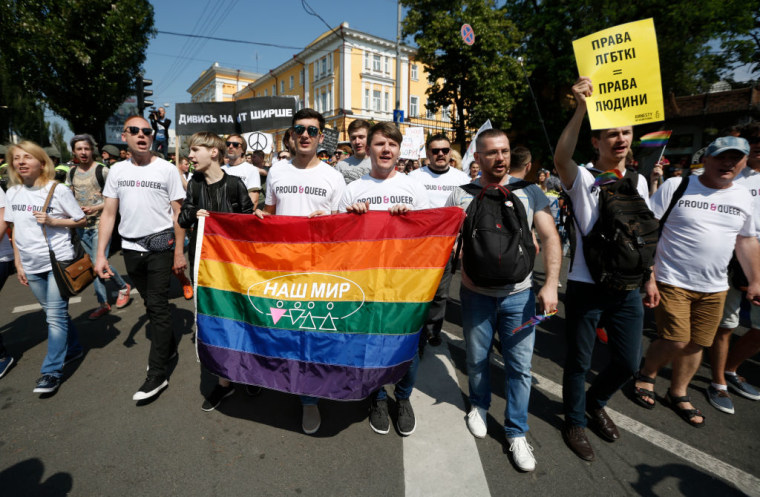Anastasia-Eva Domani was assigned male at birth but always enjoyed donning women’s stockings, high heels and makeup — secretive acts that were considered more or less a fetish when growing up in Ukraine under the Soviet Union. While living as a man, Domani, now 38, married and had a child. But last October, she decided to begin hormone treatment and her transition.
“I still have a passport and all the other documents for Oleksandr’s name,” she told NBC News, using her former name. “I will change it. But this is a complex process.”
"Forcing anyone to have surgery that they don't want or need is absolutely unconscionable.”
Dr. Jamison Green
Changing gender on legal documentation in Ukraine — such as a passport — has long been considered one of the most repressive policies found in any European country, due to its required procedures involving psychiatric diagnosis and forced sterilization.
When Domani, for example, wants to change her passport from male to female, she must first be labeled with a mental disorder and then undergo gender reassignment surgery, leaving her with effectively no control over how she identifies, but putting this decision to a number of doctors and politicians who have a binary definition of gender.
“When a transgender woman enters the hospital, she is identified in the ward according to her ‘male’ passport,” Domani said. “This causes a sense of gender dysphoria and shyness. It is very difficult to explain to the head physician your gender identity, especially if the doctor received medical education in Soviet times.”
Stereotypical gender roles engrained within society mean that a transgender person must embody the behavioral traits of the gender they wish to transition to — a transgender man should be perceived as what is understood as masculine and a transgender woman as feminine, essentially.
People like Domani are often refused legal gender recognition if they do not adhere to these principles, which is inclusive of a change of physical body parts and an implied heterosexual orientation.
“A medical practitioner sometimes doesn’t like lesbian and gay people, but they can support trans people if they are heterosexual,” said Natallia Mankouskaya, 29, an LGBTQ activist in Belarus. “They don’t understand that trans people can be lesbian or gay as well. One of the main problems are these stereotypical gender roles, the second would be the medical system.”

Amnesty International estimates there are approximately 1.5 million transgender people living in the European Union (EU), and, across the continent, restrictive roadblocks to legal gender change is paired with high levels of transphobia and gender inequality throughout medical sectors. Poor visibility of transgender communities also contributes to a lack of understanding of a transgender person’s needs.
According to a 2008 EU-wide study by the International Lesbian and Gay Association (ILGA) and Transgender Europe, only 30 percent of transgender respondents experienced a health care practitioner who was responsive when surgical or hormonal treatment was requested. The majority of the 1,964 surveyed said they were denied state funding for hormone therapy or primary surgeries.
“If you happen to be someone like Caitlyn Jenner, who has money, then you can do whatever you want with your life,” said Dr Jamison Green, a former president of the World Professional Association for Transgender Health (WPATH). “But if you’re not in that position, then you’re going to need help from some system, and if you want medical care, it needs to be the medical system.”
Traditional medical models for transgender health globally share two predominate conditions: mandatory sterilization and a mental illness diagnosis.
“First of all, forcing anyone to have surgery that they don't want or need is absolutely unconscionable,” said Dr Green, 68. “Secondly, we don’t prescribe what everyone’s genitals have to look like, why do we have to do that for trans people?”
WPATH was established in 1979 to create better access to health care and new standards of treatment for transgender patients, many of whom turn to unsafe black market treatments when medical systems fail them.
In 2010, the nonprofit organization released a statement outwardly against sterilization, urging countries to remove any surgical procedures as requirement for legal gender recognition. Earlier this year, the European Court of Human Rights (ECHR) agreed with them, ruling that forced state sterilization was in violation of human rights.
“It’s taken decades to get to this decision of the court,” said Sophie Aujean, policy officer at ILGA Europe, who works with LGBTQ advocates on a national level to improve health legislation.
“We see more and more countries that are actually changing their laws, and that there’s a clear divide between Eastern and Western Europe, with some exceptions. Changing this legislation is not necessarily something that will bring you a lot of support from the general population.”

The ECHR ruling is expected to work toward ridding forced sterilization in the 20 European countries where it is still practiced, which ILGA and Transgender Europe list as: Armenia, Azerbaijan, Belgium, Bosnia and Herzegovina, Bulgaria, Czech Republic, Finland, Georgia, Greece, Latvia, Lithuania, Luxembourg, Montenegro, Romania, Russia, Serbia, Slovakia, Slovenia, Switzerland and Turkey.
But, as Aujean points out, decisions by the ECHR are not as binding as national legislation or an EU directive.
“There’s still a lot of room for improvement,” she said. “Another big battle is the diagnosis of a mental disorder, which is extremely pathologizing for trans people. This is essentially labeling a whole population as having a mental health issue.”
ILGA and Transgender Europe state that 36 countries in Europe require a mental health diagnosis for legal gender recognition change and access to health care, a stigmatizing classification that rests on the notion that a transgender person has something inexplicably wrong with them. Legislation like this trickles down, mirroring societal attitudes toward transgender communities.
“In small towns and villages, where the population knows practically nothing about transgender people, everyone considers us perverts and mentally ill people trying to oppose the church and family values,” Domani said. “So the destruction of gender stereotypes is slower than we would like — before you sit on a two-wheeled bike, you need to learn how to ride a three-wheeled.”
Next year, the World Health Organization will meet to revise its International Classification of Diseases, where LGBTQ advocates hope to see the depathologization of trans people.
At the end of 2016, Ukraine changed its controversial legal gender recognition policy, but worrying conditions, including surgery, still remain. The legislation is currently undergoing revision.


